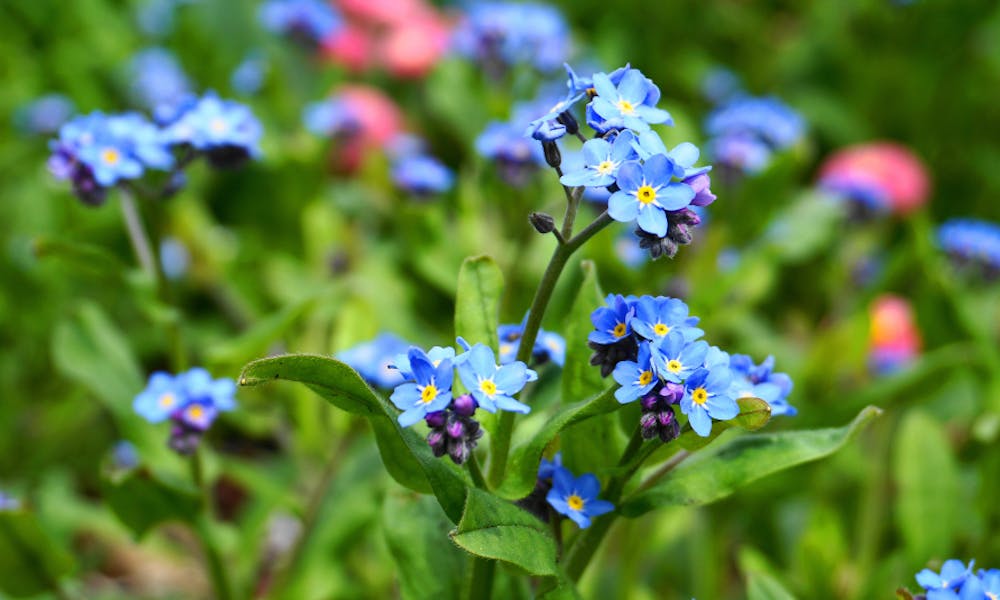There are a multitude of plants to use for ornamental purposes in your house. There are many varieties, from big to small, scented, not scented, and everything in between, but the truth is that all look lovely.
Small flowering plants shouldn’t be overlooked when ornamenting your garden, because they can be very versatile, they can be convenient fillers, planted between pavers, or even tucked into a rock wall; the possibilities are endless.
In this article, we take a look at the best tiny flowers for gardening and ornamenting, and they include:
*Thyme
*Sweet Alyssum
*Cerastium Tomentosum
*Rock Cress
*Lobelia
*Kenilworth Ivy
*Myosotis
*Fairy Foxglove
*Baby‘s Breath
Thyme
Thyme, also known as Thymus vulgaris, accomplishes two purposes in your garden. They can be grown for ornamental purposes, as well as for culinary ones. The culinary variety is also known as Italian oregano.
Thyme requires a full sun and adequate drainage to properly develop, and they react well to shearing when the spring flowers fade.
They have purple flowers, which come back after a short period of time, attracting bees and wasps for pollination. It has thin stems, upon which grow clusters of leaves, and it provides a great and savory taste to your meals, especially soups and vegetables.
Sweet Alyssum
The scientific term is Lobularia maritima, and this flower gives off a scent that is so sweet it’s often mistaken with the scent of honey. These flowers are a common offering in early spring all over garden centers.
Their seeds have a quick germination period, often spanning less than one week. The transplants flourish in cool environments and spring weather. It is also beneficial to trim your sweet alyssum when the flowers are scarce to revitalize the plant.
They come in a variety of colors, ranging from pink and orange, to white and red, and they thrive in neutral pH, rich soil with a full as well as a partial sun exposure.
Snow-in-Summer
Also known as Cerastium tomentosum, these flowers have a silver foliage, and they are very resilient. It belongs to the perennial category, which refers to its lifespan, being able to live more than two years.
They are very versatile, boasting numerous white flowers, being excellent between pavers in your garden, or to fill crevices. They are also ideal in rock gardens, due to the fact that they flourish at a full sun exposure, as well as in draining soils, and they can also be excellent candidates for alpine gardens.
They come only with white, but they are beautiful flowers, require well-drained soil to flourish, and full sun exposure.
Rock Cress
Rock cress, or Arabis, boast a wide variation of hybrids, coming in different colors and sizes. The stunning flowers come in a bright purple color and is an excellent addition to your garden.
They come in a wide range of colors, from pink to purple and blue, which offers many choices. These are mid to late spring bloomers with evergreen foliage which boasts a multitude of brightly colored flowers on plants that range from 2-4 inches.
After flowering, it is advised to trim the plant so it can retain the compact shape. They require full sun exposure to thrive, as well as a slightly acidic and well-drained soil.
Lobelia
Lobelia, or Lobelia erinus, boasts a plethora of brilliant flowers, colored in bright blue, which are a common filler plant. These bloom in early spring, and they are best displayed in hanging baskets or containers.
The many varieties of this plant offer a flowering period spanning even in hot weather. They require full sun and a well-drained soil to flourish.
Kenilworth Ivy
Also referred to as Cymbalaria muralis or ivy-leaved toadflax, as a perfect addition to your garden, adding texture to it even when it’s not flowering. These are resilient as well, being able to retain their blossoms from spring all the way until fall, given that they have moist soils and a decent shading.
They come in a lavender color, and are robust in warmer weather. They are also capable of self-seeding in cooler regions.
Myosotis
Also known as Forget-me-not, these plants are very resilient and require low maintenance. They are not bothered by nearby animals, and they bloom in April and May.
The colors of this beautiful flower range from blue, white, yellow, and pink. The blue flowers have yellow coloring in the center, and they give off a pleasant scent.
They are perennials, but have a short lifespan. However, they are capable of self-seeding given the right conditions, and return for a long period of time.
They come in many brilliant colors, require a partial or full sun exposure to flourish, as well as a moist or a well-drained soil.
Fairy Foxglove
This flower bears many names, from Erinus alpinus, to the alpine blossom and starflower, this beautiful flower has petals that look like feathers, as well as stems, dark green in color, which grows from a seed. These flowers are easier to cultivate when the plant is purchased already matured.
Differentiating the fairy foxglove from other plants for rock gardens, these can grow in partial shade, as well as flourishing in crevices and walls.
The colors range from pink to purple and white, and they thrive in full as well as partial sun exposure, and in any type of soil.
Baby’s Breath
Baby’s breath, or gypsophila, is commonly used in Valentine’s bouquets, but they shine the most in gardens. This flower lives more than two years, and despite the tiny appearance and thin stems.
Plants flourishes in dry, as well as average soil, but this particular plant is best suited for alkaline soil, making it perfect for rock gardens. This flower also blossoms in April, all the way until late summer, and can be a reliable plant.
The colors range from white, pink, purple, yellow, red, and orange, requiring a full sun exposure and an alkaline soil to thrive.
